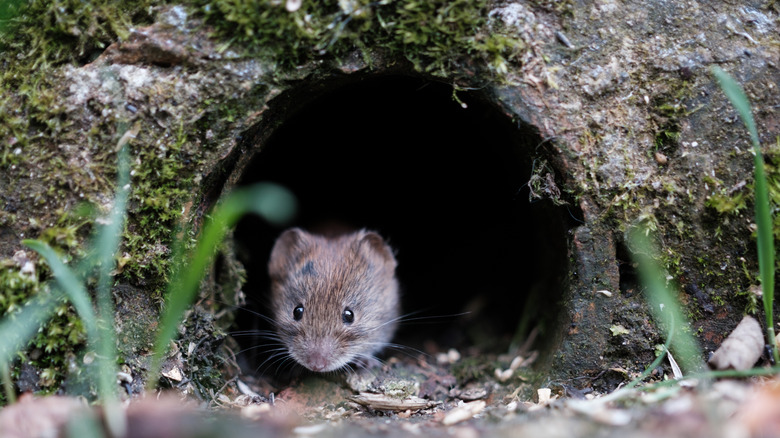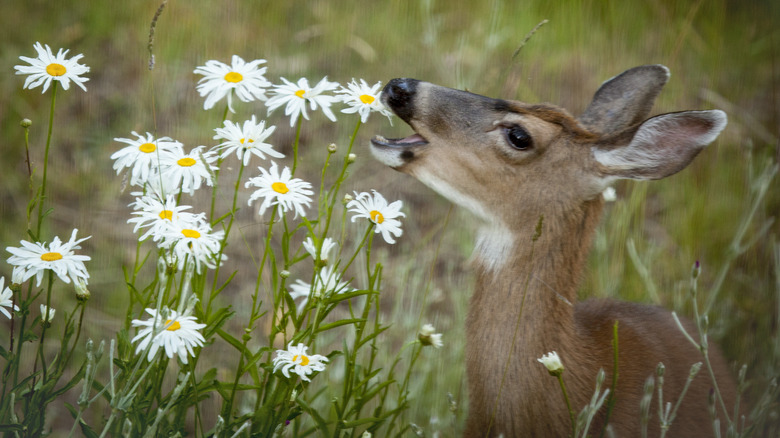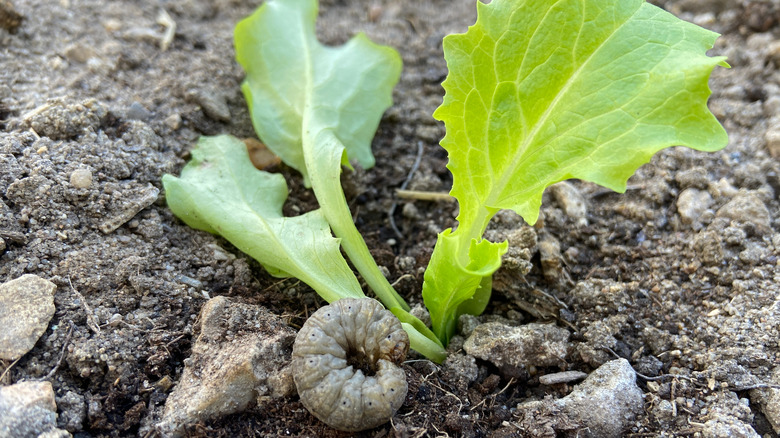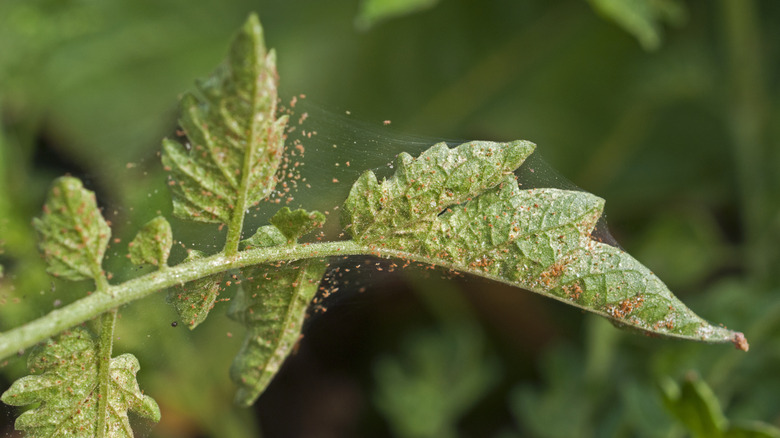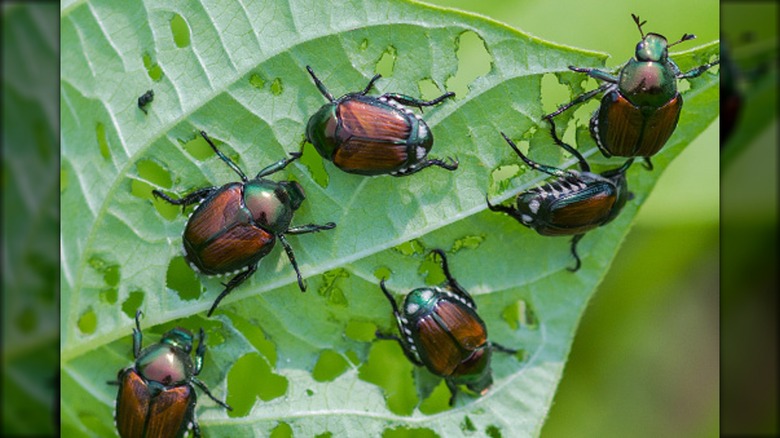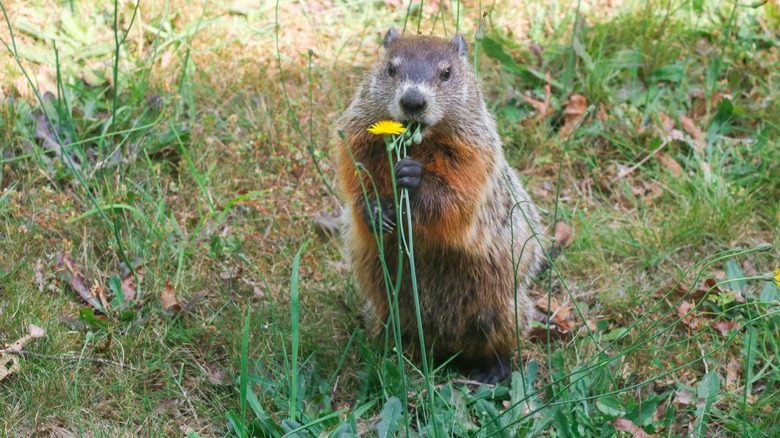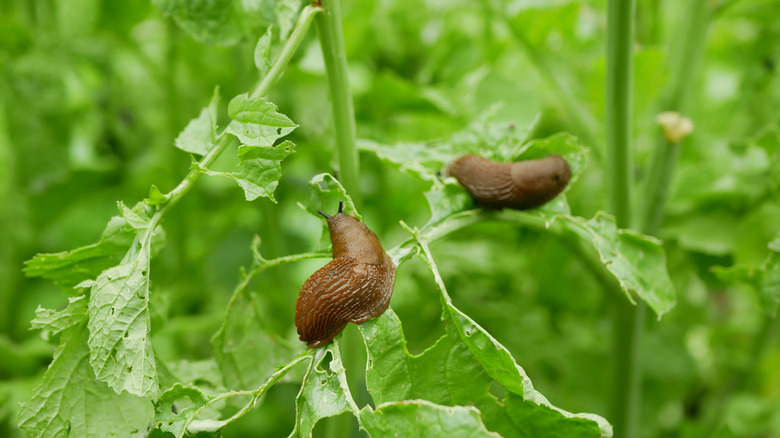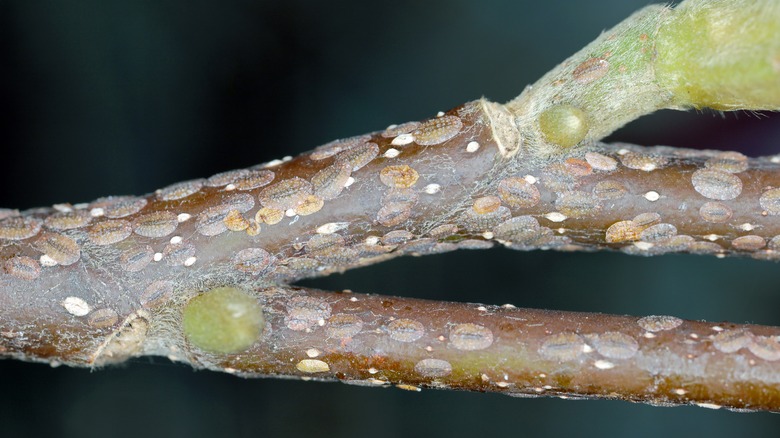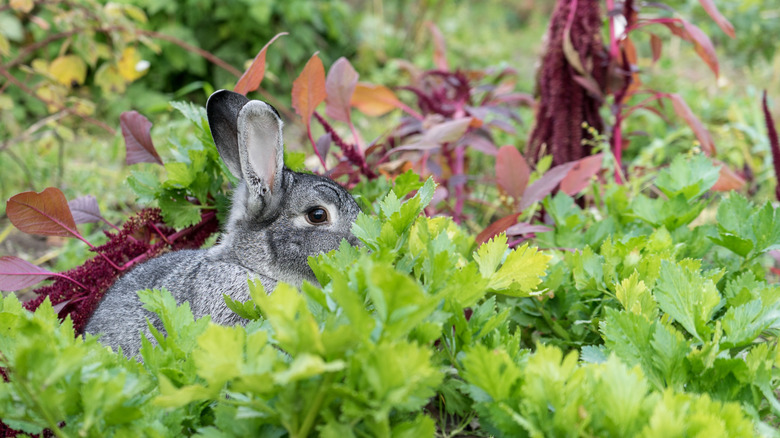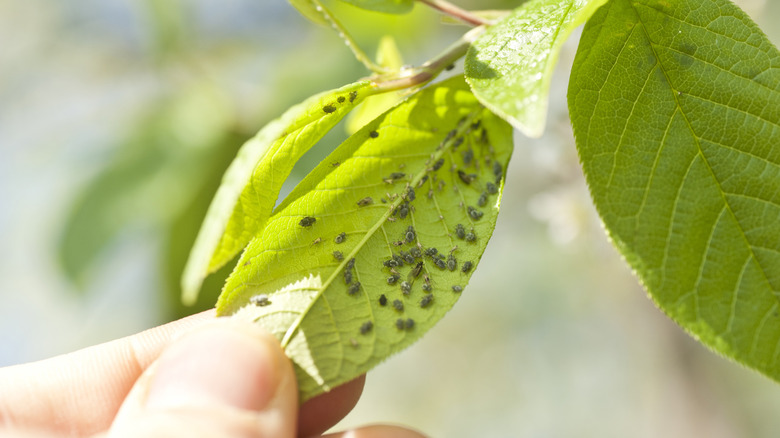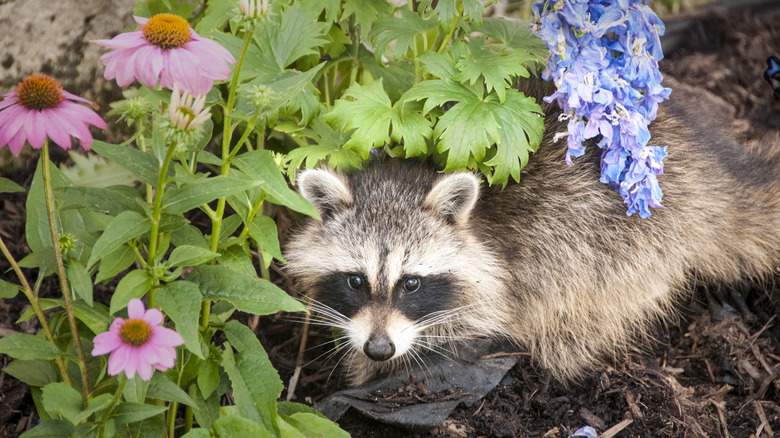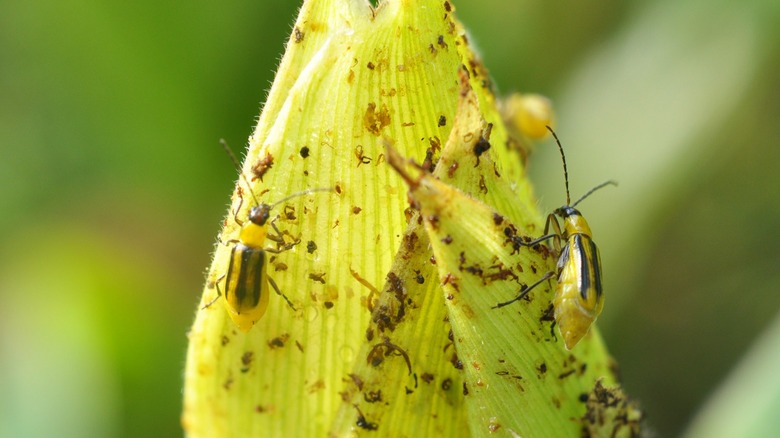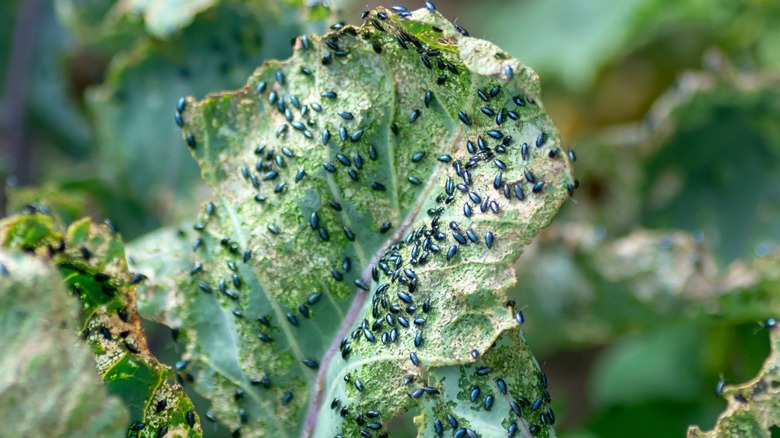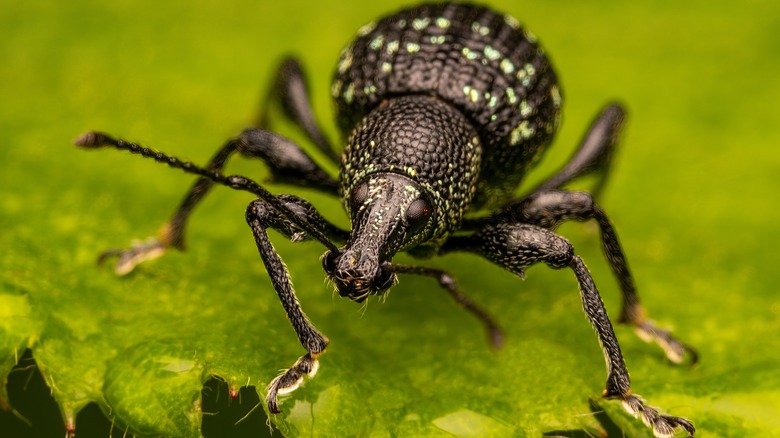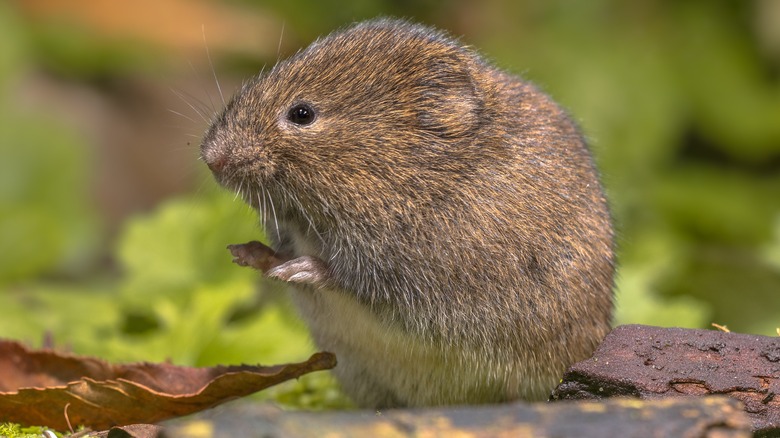The Worst Garden Pests You'll Want To Banish From Your Yard Immediately
Wilted or yellowed leaves. Stunted growth. Bitten off flowers. Deformed fruit. Sooty mold on the branches. Whether you're an avid gardener or just starting to test out your green thumb, reading through this list likely sent shivers up your spine. These types of damages are among the worst nightmares of anyone who spends time in their garden. Beyond being the stuff of nightmares, what do they all have in common? They are just a few examples of the damage that pests can cause to the plants in a flowerbed or yard.
Insects, rodents, and other creatures can wreak havoc on your prized plants, quickly transforming your garden from a thing of beauty to a sad mess. Let's take a look at some of the worst of the worst so you'll know when to act and what you should do to banish these irritants and prevent them from being a threat to your flowers and plants.
Deer will munch on flowers and plants in your yard
While it may seem cool to see a deer in your yard, they pose a real threat to several types of plants — especially when there are lots of them in the area. The animals like to eat everything from the buds to the stems of different ornamental plants and can wipe out sections of your garden at a time. Deer do not have upper incisors. So, instead of neatly biting at leaves or flowers, they have to tear them off with their mouths. You can identify whether deer are to blame for your damaged plants by inspecting them. If the leaves and tears look more jagged, then these animals are the likely culprits. They're also taller than smaller critters, such as rabbits or squirrels, so the damage you spot may be at higher levels off of the ground. Chomping on your prized beauties isn't the only way deer can threaten your yard. Males with antlers can damage the bark or leaves on trees or shrubs by rubbing up against them. This can leave visible scrapes or even sections that are shredded off.
If you want to keep deer out of your yard, there are a few things you can try. There are repellent sprays that make your plants smell unappealing to the animals, which will make them less likely to stop by for a quick bite. Building a fence can also be an effective solution. However, because deer can jump high, the fence should be a minimum of 8 feet, which may not be allowed by your HOA. Another idea is to set up obstacles, such as rocks or stacked logs, that will make it more difficult for the deer to access your plants.
Cutworms can slice off entire plants at their base
Despite their harmless appearance, cutworms are far from innocent. These caterpillars, which only reach about 2 inches in length when fully grown, are the larvae of about 200 different species of moths. They rest during the day and then come out at night to eat. And, unfortunately, they often feed on the plants in a garden. Some remain underground, eating the roots and stems of a plant, causing it to wither. Others stay around the top of the soil and wrap their bodies around a plant stem. As they feed, they will eventually cut through it like a beaver through a tree, hence the pests' name.
Cutworms feed on several different types of plants, including beans, carrots, celery, asparagus, peas, lettuce, tomatoes, potatoes, and corn. They can often pose a bigger risk to new garden areas that were just created by breaking down areas that were once covered in grass. This is because the adult moths often lay their eggs in grass and weeds, so their larvae may be more likely to be present in the soil. To minimize the risk of an infestation in a new garden bed, dig out your path a minimum of two weeks before you plan to plant anything. This starves the larvae of any food source, making it less likely you'll have an infestation. Introducing some nematodes can also help you get rid of cutworms. Nematodes are a predator of the pests. Neem oil is also effective at stunting the development of cutworms and can help prevent their population from growing.
Spider mites may be small, but they can cause serious damage to your plants
Spider mites are a member of the arachnid family with eight legs. However, unlike many other types of spiders, the mites are very small — so small that you won't be able to see them with your eyes. But, don't let their tiny size fool you. These pests can cause big damage to your crops and plants. They suck the juices from leaves and plants. Early signs of damage include dotting across the surfaces of the leaves, sort of like freckles. You may also notice that a few of the leaves start to turn brown. If action isn't taken quickly and there is a large infestation, the leaves may turn yellow and completely fall off of the plants, indicating they're damaged beyond repair.
If you're dealing with an infestation of spider mites, you can try regularly putting your plants under a heavy spray, such as under a shower head or the spray of a sink faucet. Doing so will knock off many of the mites. Similarly, some horticultural oil sprays can also be effective at killing the mites without damaging your plants. Insecticidal soaps, rosemary essential oil, or a DIY spray made with hot sauce, water, and liquid dish soap can also be an effective way to keep the pests from causing further damage.
Japanese beetles can leave the plants in your garden full of holes
If you live on the East Coast or Midwest, you'll want to look out for signs of a Japanese beetle infestation. Classified as one of the major pests in these regions, Japanese beetles are capable of causing harm to hundreds of varieties of plants. However, there are certain plants that they seem to really enjoy, including roses, grapes, raspberries, and beans. The most characteristic sign of damage is leaves riddled with massive holes. The beetles will eat all of the fleshy parts of the leaf, leaving only the veins. Adults are not the only ones that can pose a threat. When the grubs hide in the soil during the off-season, they like to eat the roots of nearby plants. You might be able to guess that they're to blame if you notice brown, splotchy patches of grass on your lawn.
Japanese beetles are approximately half an inch long. You can distinguish them from other types of beetles by looking at their heads, which will be a metallic blue color. If you see them on your plants or notice signs of their damage, pick any that are visible off by hand and put them in a bowl of water mixed with a squirt of dish detergent. You can also apply neem oil to the plants to kill any larvae before they have the chance to turn into adults.
Groundhogs can burrow through your garden and disturb your crops
You may enjoy watching Punxsutawney Phil predict whether we'll have an early spring or face six more weeks of winter each year, but spotting one of his cousins in your backyard is not a welcome sight. Groundhogs can be very destructive, ruining plants, chomping on food you plan to harvest, leaving claw marks on bushes and trees, and more. These burrowing creatures can dig tunnels beneath the surface of your lawn, leaving several holes along your grass or even within your garden.
If you want to keep groundhogs away and stop them from trying to sabotage your green thumb, there are a few things you can do. First, try placing a fence around your garden. You'll need to make the fence at least 6 feet tall and bury it a minimum of 18 inches below the ground. Otherwise, the pests will just dig right under it or clamber over it. When your fruits or vegetables ripen, pick them quickly. You aren't the only one who will enjoy these ready-to-enjoy treats, so remove them before the groundhogs get a chance. Be sure to also keep your lawn mowed short to take away potential hiding spots. Groundhogs do not like cayenne pepper or Tabasco sauce. Applying these household staples around your plants can also deter the critters from stopping by.
Slugs munch on leaves, leaving damage in their wake
Slugs are most likely to pose a threat to your garden in the spring, summer, or fall. They seek damp and cool areas and try to stay away from direct sunlight. Beyond their unpleasant, slimy appearance, slugs can pose a threat to your plants. They like to eat several species of plants, particularly those that grow in the shade. A few that they don't mind snacking on include hostas, delphiniums, pulmonaria, strawberries, cabbage, lettuce, and basil. You can often identify slug damage because the holes will have an irregular, asymmetrical shape. If there are just a few slugs present, the damage shouldn't be too severe. However, an infestation can cause more drastic damage, potentially impacting the growth of fruits and vegetables.
Slugs are larger than some other pests and are thus easier to spot. As unpleasant as it may be, pick up and move any slugs you spot away from your garden. Be sure to don a pair of gloves to keep your hands from getting slimy. You can also sprinkle some used coffee grounds in your garden soil. The slugs will be deterred by the stronger scent of the grounds. The coffee can also help deliver important nutrients to your garden, so it really is a win-win. Crushed eggshells offer a similar benefit. They can act as a natural fertilizer while also creating a sharp barrier that slugs won't want to cross.
Scale suck the sap from plants
No gardener wants to hear that their plants are covered with scale. These tiny insects are so small that many people assume they are just spots of discoloration caused by some disease. However, they are actually little insects that use their sharp tongues to suck the sap out of plants. This weakens the plant, disrupts its growth, and may even cause the plant's leaves to yellow or drop. With a heavy infestation, scale can completely wipe out several plants in your garden. What's more, some scale species make something called honeydew. This secretion causes sooty mold to grow on the plants, further endangering them while also attracting unwanted ants.
If you want to get rid of scale on plants, start by pruning any infested sections of your plants. Doing so can help you cut off the infestation and prevent it from worsening. You may also want to try using neem oil, a natural pesticide that can stop the scale from being able to feed or continuing to propagate. In addition to that, ladybugs are a natural predator, so introducing a few to your garden can also help you ward off scale and save your plants.
Rabbits eat much more than just carrots in the garden
Rabbits may be cute, but they can only spell trouble for your favorite flowers and plants. Why do you think Mr. McGregor was so determined to keep Peter out of his garden? We often think about rabbits munching on carrots, but they can actually devour several other types of plants, including lettuce, broccoli, beans, pansies, marigolds, and petunias. What's more, rabbits multiply quickly, meaning a few stray animals in your home could quickly turn into a full-blown infestation.
To keep rabbits from destroying your garden, there are a few things you can try. One is to block the rabbits from getting at your plants. Try putting up a fence with chicken wire or something similar that will prevent the smaller creatures from weaseling their way in. You can also try planting some of the flowers and vegetables that rabbits do not enjoy eating in hopes of convincing them to leave. A few of these options include primroses, peonies, butterfly bushes, tulip trees, daffodils, and Adam's needle. Rabbits also do not like the strong scent of crushed red pepper and garlic. You can use these two spices, along with some dish soap and water, to make a natural deterrent spray to spread around your garden and any plants that these fuzzy creatures seem to target.
Aphids weaken plants by sucking out their cell contents
Aphids are another small garden pest that thrives by sucking the cell contents out of your beautiful plants. While a few aren't likely to cause any major harm, an infestation can leave your plants significantly weakened, interfere with their ability to produce healthy flowers or fruit, and more. You can spot the damage they've caused by looking for curled or yellowing leaves. Aphids also can leave behind honeydew sap that can attract ants or cause sooty mold to grow. These bugs are hard to spot at first — with adults measuring less than ¼-inch long. They may be green, black, brown, gray, white, yellow, or pink in color. The various species are attracted to different types of plants, some of which include beans, potatoes, peaches, and melons. You're most likely to see a group of aphids together rather than one or two by themselves.
A few aphids can quickly turn into a larger problem because these pests multiply so rapidly. Once you notice any on your plants, you'll want to act quickly. Start by spraying the plants with water to knock off as many pests as possible. Once you've removed as many as possible using this method, try spraying a solution of water and soap on the plant — particularly the undersides of the leaves and petals and the stems — to get rid of any remaining bugs. Neem oil, rubbing alcohol, and diatomaceous earth can also be effective at clearing up an aphid problem.
Raccoons aren't picky and will feast on several of your beautiful plants
In addition to breaking into your trash cans and stealing sweet nectar from your hummingbird feeders, raccoons can also make a mess of your gorgeous garden. They might just help themselves to a midnight snack of any of the fruits, vegetables, or flowers you have growing. There are certain crops that they seem to prefer, including pears, apples, peaches, corn, and peas, but they won't necessarily limit themselves to these offerings. The pests may also dig up patches of your lawn or garden looking for grubs and other insects, further damaging your hard work.
One of the most effective ways to deter raccoons from visiting your yard is to use some Epsom salt. The magnesium sulfate blend of this household staple bothers a raccoon's nasal passages. They'll aim to stay as far away from it as possible, so sprinkling it around your garden and any other areas you want to deter them from can work well to keep them away. Just be prepared; you'll need to reapply more Epsom salt periodically as it will lose its potency over time and when it rains.
Cucumber beetles and their larvae cause serious harm to several types of plants
Cucumber beetles are another garden pest that you'll want to quickly evict as soon as you discover their presence. There are two varieties of these insects, which are active towards the end of May or the beginning of June: striped cucumber beetles and spotted cucumber beetles. The striped varieties eat the blooms of flower plants, such as cucumber and squash. After mating, adult females lay their eggs in the plant's dirt, and the larvae will eat the roots and stems after hatching. Spotted cucumber beetles lay their eggs on corn, grass, or other non-gourd plants. Their larvae then feed on the roots of these plants. In addition to eating the leaves, beetles can cause additional damage. For example, striped cucumber beetles can cause bacteria that will make plants droop and wither.
Now that you know more, you surely want to keep cucumber beetles out of your garden. One way you can do so is by laying mulch along the bases of your plants, particularly those in the gourd family. Doing so can deny the pests access to their preferred location for laying their eggs. Another strategy is to plant marigolds, sage, catnip, or other plants with a stronger scent near your cucurbits. Their scent will make it more challenging for the cucumber beetles to locate the crops they want.
Flea beetles leave tiny holes and can spread bacteria to flowers and crops
If you've recently noticed some very small holes in the plants in your garden, flea beetles might be to blame. Flea beetles — which can jump like the fleas that infest animals — can be either blue, black, or brown in color. They're also tiny, only measuring up to ¼-inch long. In addition to chewing holes in your plants, these pests are also carriers of fungal blight, bacterial wilt, and other diseases that can take out your crops.
Because of their potential to cause serious harm, you'll want to act quickly to get rid of flea beetles. You can try dusting the leaves of your plants using talcum powder. The beetles don't like the powder and will try to stay away from it. Another idea is to make a DIY repellent spray using water, isopropyl alcohol, and dish soap. Spraying it on your plants can offer them some protection against the bugs. You can also take some measures to prevent flea beetles from appearing in the first place. Instead of transplanting your seedlings to an outdoor garden bed as soon as they're ready, try to keep them inside for a few additional weeks. This way, you won't be providing the newly hatched pests food, and they'll be more likely to go somewhere else.
Vine weevils can chew leaves and stunt the growth of the plants in your garden
Adult vine weevils, along with their young larvae, are capable of inflicting rather severe damage to a wide variety of plants that may be growing in your yard or garden. The adults will chomp on plant leaves throughout the night. And, while their chomping isn't likely to threaten the health of the plants, the C-like holes their feeding leaves behind will have a negative impact on its appearance. However, it is the larvae of this species that pose the greatest threat to plant health. They munch on the roots and lower stems of flowers and other crops growing in your garden, which can either stunt their growth or kill them altogether.
To prevent an infestation in your garden, be sure to perform a thorough inspection of any new plants, particularly around the roots, before transplanting them to your garden. Be sure also to prune your plants to leave spaces between them and trim low-lying branches. This way, the vine weevils, which can't fly, won't be able to move between plants.
Voles dig burrows, chomp on plants, and cause more damage to your yard and garden
Voles are a member of the same family as hamsters and mice. They have a similar appearance to both of these animals and are often referred to as meadow mice or field mice because of their resemblance to the critters. The pests are small, generally measuring between 4 and 8 inches in length, but, once again, don't let their smaller size and rather cute appearance fool you. Voles are responsible for causing lots of damage to yards, gardens, and crops. They have insatiable appetites, dig burrows, strip the bark off of trees, and more.
If your yard is plagued by voles, you can try building a barrier around your garden crops. These animals may be fast runners, but they are not very good at climbing. You can also try laying a gravel barrier and gravel moat around your garden. The voles won't want to burrow through the heavy rocks and will go find an easier area to live. You can also try planting some onion or garlic, as these are two natural repellents for the critters. Spreading crushed onion, garlic, pepper, or thyme around your plants may also help prevent them from being a problem.
